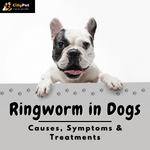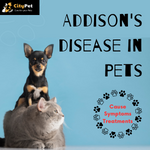Common Skin Problems In Dogs?
Our beloved four-legged friends have skin underneath all that fur, just like humans. Skin disorders are one of the most common illnesses in dogs and can be caused by a variety of diseases or factors. These conditions range from minor to serious and can even spread to other animals and people. To help keep your pup safe and healthy, here are some of the most widespread canine skin issues along with tips on how to treat them:
Common Skin Problems:

There are several common skin problems that dogs can experience. Here are a few:
- Allergies: Dogs can have allergies to a variety of things, including food, pollen, dust, and flea bites. Allergies can cause skin irritation, itching, redness, and hair loss.
- Fleas and ticks: Fleas and ticks are common parasites that can cause skin irritation and infections. They can also transmit diseases to your dog.
- Hot spots: Hot spots are areas of skin that are inflamed and irritated. They are usually caused by allergies or flea bites and can be very painful for your dog.
- Bacterial and fungal infections: Dogs can develop bacterial and fungal infections on their skin, especially in warm and humid climates. These infections can cause itching, redness, and hair loss.
- Dry skin: Just like people, dogs can experience dry skin. This can be caused by a variety of factors, including weather, allergies, and poor nutrition. Dry skin can be itchy and uncomfortable for your dog.
- Skin cancer: Skin cancer is a relatively common problem in dogs, especially in older dogs and dogs with light-colored fur. Signs of skin cancer include lumps or bumps on the skin, sores that don’t heal, and changes in the color or texture of the skin.
If you notice any of these skin problems in your dog, it’s important to consult with your veterinarian. Your vet can help diagnose the problem and recommend the appropriate treatment to keep your dog comfortable and healthy.
Treatment of Common Skin Problems in Dogs:

The treatment of common skin problems in dogs can vary depending on the specific condition, but here are some general guidelines:
- Consult with your veterinarian: If you suspect that your dog has a skin problem, it’s important to take them to the vet for a proper diagnosis. The vet can recommend the appropriate treatment based on the specific condition.
- Medications: Your vet may prescribe medications to help treat the skin problem, such as antibiotics or antifungal medication for infections, anti-itch medications for allergies, or topical ointments or creams for hot spots or skin irritations.
- Topical treatments: Topical treatments, such as medicated shampoos, sprays, or creams, can be used to help treat skin conditions such as flea and tick infestations, infections, or allergies.
- Dietary changes: If your dog’s skin problems are caused by a food allergy or sensitivity, your vet may recommend changing their diet.
- Flea and tick prevention: If your dog’s skin problems are caused by fleas or ticks, it’s important to use flea and tick preventatives to eliminate the infestation and prevent future problems.
- Hygiene: Proper hygiene can also help prevent and treat skin problems. Regularly bathing your dog with a mild shampoo and keeping their bedding and toys clean can help reduce the risk of skin infections.
- Managing underlying conditions: If your dog has an underlying condition, such as hypothyroidism, that is contributing to their skin problems, your vet may recommend treatment for that condition as well.
Overall, the treatment of common skin problems in dogs involves a combination of medications, topical treatments, and changes to your dog’s diet and hygiene routine. By following your vet’s recommendations and being diligent about preventing and treating skin problems, you can help keep your dog’s skin healthy and comfortable.
Preventing Common Skin Problems in Dogs:
Preventing common skin problems in dogs is an important part of keeping your furry friend healthy and comfortable., but there are several things you can do to help keep your dog’s skin healthy:
- Regular grooming: Regular grooming can help remove dirt, debris, and loose hair from your dog’s coat. It also allows you to check your dog’s skin for any signs of irritation, bumps, or infections.
- A healthy diet: A balanced and nutritious diet can help keep your dog’s skin healthy and reduce the risk of skin problems. Talk to your vet about the best diet for your dog.
- Avoiding allergens: If your dog has allergies, try to identify and avoid the allergens that trigger their symptoms. This may include certain foods, pollen, or other environmental allergens.
- Flea and tick prevention: Use flea and tick preventatives to help prevent infestations that can cause skin irritation and infections.
- Regular vet check-ups: Regular check-ups with your vet can help identify and treat any skin problems before they become more serious.
- Proper hygiene: Keep your dog’s bedding, toys, and other items clean and free of bacteria and other pathogens. Regularly clean your dog’s ears and brush their teeth to prevent infections.
- Protect your dog from the sun: Like humans, dogs can also get sunburnt. Make sure to protect your dog from the sun’s harmful rays, especially during peak hours by providing shade, using dog-friendly sunscreen, or covering them with protective clothing.
By following these tips, you can help prevent many common skin problems in dogs and keep your furry friend healthy and happy.
City Pet Hospital is a comprehensive pet portal that provides health consultation for your pet and an array of products designed to make your life as a pet parent easier and more enjoyable. We are dedicated to innovation, providing content for our customers, and creating the ultimate platform for your pet’s well-being.
What sets us apart? Pet parents want us!
Our mission is simple: To bring joy to you and your furry family member by making their lives easier.
With City Pet Hospital – You Parent, We Pamper
Come on, Together, let’s revolutionize the pet space.








































